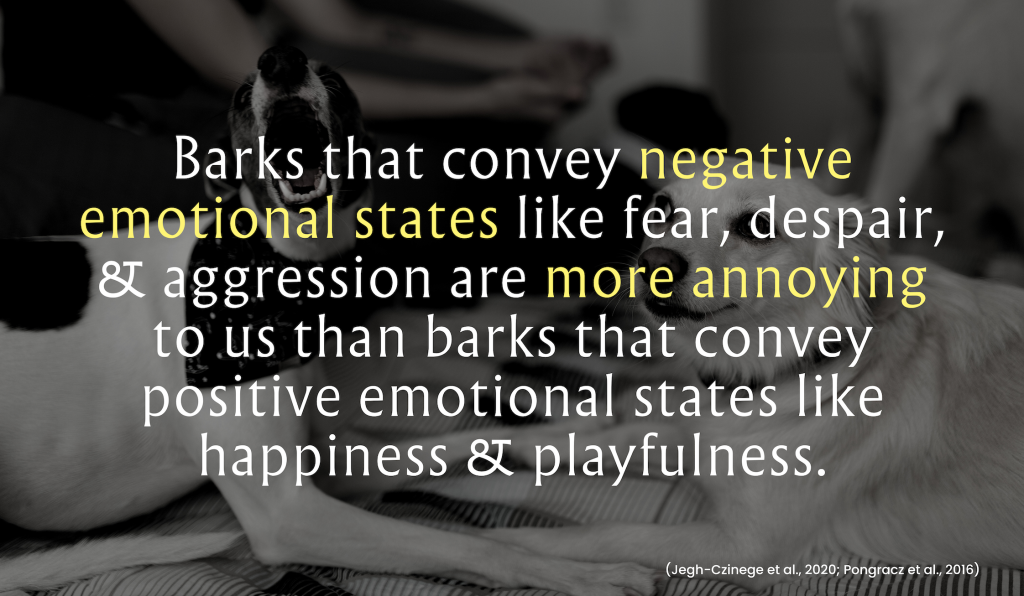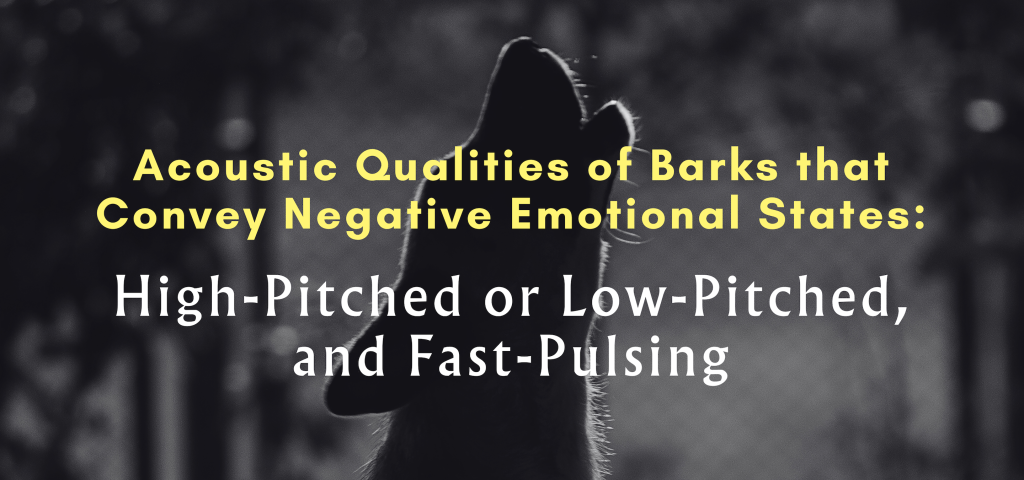
Welcome to the blog!
This week, we’re exploring the science of barking—more specifically, we’re taking a look at why certain types of barks are more likely to annoy us than others.
The research included in this newsletter is part of a larger research project that will inform an upcoming Dogs Unknown podcast episode, all about the evolution of barking in domestic dogs. Stay tuned!
Happy Reading,

The Different Types of Dog Barks
(and why some barks annoy us more than others)
Barking is a commonly cited nuisance behavior for many people, dog owners and non-dog owners alike. A study conducted in 2015 (Raglus et al., 2015) cites ‘nuisance’ barking as a huge behavior problem that is exhibited by as many as 1 in 3 pet dogs around the world (!), and is the cause of everything from relinquishment of dogs to shelters to neighbor disputes, fines, and evictions.
But not all barks are created equal on the nuisance scale…and there’s a good evolutionary reason for that.

Barking as Communication
First things first, did you know that our dogs’ barking is a product of domestication? Grey wolves—the closest relatives of dogs—bark in only a couple of very specific contexts. When wolves do bark, it includes a single bark or perhaps a short burst of barks. Further, most barking amongst wolves is displayed by juveniles as opposed to adult wolves. The same holds true for other wild canids. Indeed, barking has “turned out to be almost a ‘trademark’ for dogs…[who] bark in a strongly repetitive manner and in almost every possible context” (Pongracz, 2017).
Despite the fact that barking occurs frequently and in such a wide range of contexts among domestic dogs, up until these last few decades, it was assumed by scientists that barking didn’t really serve a specific communicative function.
Instead, scientists theorized that barking was a sort of by-product of domestication, rather than a communicative adaptation to help dogs thrive in their new human-centric living environment.
Our understanding of barking as more targeted communication started to change in 2002, when Dr. Sophia Yin published studies showing that dogs reliably use different types of barks in different contexts, including in states of play, separation, and territorial aggression (Yin, 2002; Yin & McCowan, 2004).
In 2005, Pongracz et al. conducted a study that analyzed barks in Yin’s original three contexts, plus three additional ones. The six scenarios tested included: “Stranger at the gate”; “Schutzhund training”; “Preparing for a walk with owner”; “Asking for a ball”; “Play with owner”; and “Left alone”. Once again, the researchers found that barks from different contexts had reliably different auditory characteristics.
Thanks to these studies (and a handful of others), it is now widely accepted that barking serves an important communicative function for our dogs—and that we as humans are pretty darn good at accurately understanding at least a subset of those bark types, regardless of our level of experience with dogs (Pongracz et al., 2005).

Some Barks are More Annoying than Others
So, we know our dogs reliably use different barks in different contexts. This is probably not terribly surprising news to any of us who share our lives with dogs. But, researchers have also recently found that there are select types of barks that cause us to become especially annoyed and agitated.
In 2020, Jegh-Czinege et al. conducted a study that had participants listen to different types of dog barks, then rate them according to how annoying they found them. The researchers found that bark types conveying a positive emotional state (happiness, playfulness) were negatively correlated with nuisance scores of participants, while bark types conveying a negative emotional state (fear, despair, aggression) where positively correlated with nuisance scores.
In short: happy barks don’t seem to cause us much agita, but fearful, desperate, and aggressive barks often test our nerves and our patience.

Perhaps you’re wondering which contexts, specifically, caused participants the highest levels of annoyance (or, maybe you’ve already guessed).
Both Jegh-Czinege et al. (2020) and Pongracz et al. (2016) found that, of the bark contexts they tested, people rated the following as most annoying:
- Barks that occur when a dog is left alone
- Barks that occur when a dog is alarmed about a stranger
Interestingly, it’s also these “negative emotional state” barks that human adults are most accurate at categorizing—we do a great job of identifying these types of barks, even when we don’t have any experience with dogs (Pongracz et al., 2005).
Your Heightened Annoyance Serves a Purpose
So, we’re really good at recognizing barks that convey negative emotional states. And, we find these types of barks particularly attention-getting and annoyance-inducing. Why?
Fearful, desparate, and aggressive barks have specific auditory qualities that activate biologically-rooted “emotion-attribution rules” we use to assess vocalizations of other (human and non-human) individuals (Andics & Faragó, 2018). Depending on the assessed emotion of the signaler, we register certain calls as more important and biologically relevant.

Researchers suggest that our heightened annoyance response to fearful or desperate barks is rooted in the same type of biological response we have to the sound of a baby crying: it’s an attention-getting, biologically relevant sound that signals an urgent need from a vulnerable/dependent individual. So long as the crying persists, we feel upset (annoyed, agitated, anxious, etc.), because its continued presence signals to us a need that is still unresolved. (Jegh-Czinege et al., 2020).
“Aggressive” barks (more accurately described in the literature as agonistic barks), are also very biologically relevant sounds. These types of harsh, lower-frequency vocalizations are pretty universal across the animal kingdom in situations where conflict is afoot (Morton, 1994; Pongracz, 2017). From an evolutionary standpoint, it’s really helpful for us to find these types of vocalizations especially attention-getting, as they can allow us to avoid or address a potential threat in our environment (either the dog itself, or a stranger the dog may be alerting to).

Where Do I Go from Here?
We won’t be getting into recommended approaches to reduce “nuisance” (read: unwanted) barking. At least, not in this newsletter—though stay tuned for future editions that will offer some practical “how to’s” you can try at home.
For now, if you are finding your dog’s (seemingly unwarranted or excessive) barking especially annoying lately, consider this:
- Your high levels of annoyance may actually be a signal that your dog is having a really hard time with the situation, too. And they’re doing their best to communicate it to you in the best way they know how.
- Even as you take a step back and try to empathize with the negative emotions behind your dog’s barking, take solace in knowing that it is totally normal and natural to still feel annoyed or agitated by their barking. Biology is a powerful force!
Lastly, if you’re open to it, take this newsletter as a gentle nudge to more closely examine the contexts in which your dog is barking. Then, connect (or reconnect) with your trainer or behavior consultant to explore ways to reduce barking that help both you and your dog feel better.
References:
- Andics A, Faragó T. 2018. Voice perception across species. In: Frühholz S, Belin P, editors. Oxford handb voice percept. 1st ed. Oxford (UK): Oxford University Press; p. 363–392.
- Jégh-Czinege,N., Faragó, T., & Pongrácz, P. (2020) A bark of its own kind – the acoustics of ‘annoying’ dog barks suggests a specific attention-evoking effect for humans, Bioacoustics, 29:2, 210-225
- Pongrácz P. 2017. Modeling evolutionary changes in information transfer. Effects of domestication on the vocal communication of dogs (Canis familiaris). Eur Psychol. 22:219–232.
- Pongrácz P, Czinege N, Haynes TMP, Tokumaru RS, Miklósi Á, Faragó T. 2016. The communicative relevance of auditory nuisance: barks that are connected to negative inner states in dogs can predict annoyance level in humans. Soc Behav Commun Biol Artif Syst. 17:26–47.
- Pongrácz P, Molnár C, Miklósi Á, Csányi V. 2005. Human listeners are able to classify dog (Canis familiaris) barks recorded in different situations. J Comp Psychol. 119:136–144.
- Raglus TI, Groef BD, Marston LC. Can bark counter collars and owner surveys help identify factors that relate to nuisance barking? A pilot study. Journal of Veterinary Behavior 2015; 10:204-209.
- Yin S. 2002. A new perspective on barking in dogs (Canis familaris.).. J Comp Psychol. 116:189–193.
- Yin S, McCowan B. 2004. Barking in domestic dogs: context specificity and individual identification. Anim Behav. 68:343–355.
NEED TRAINING OR BEHAVIOR SUPPORT?
Check out the resources below!

Check out Instinct’s award-winning podcast, Dogs Unknown (fka DogLab), hosted by Instinct Co-Founders Sarah Fraser (me!) and Brian Burton.

Join one of our free, live training & behavior seminars via Zoom!
Hosted by Instinct behavior consultants, these seminars include a 1 hr presentation plus live Q&A session. Open to all!

Sign up for the Nature-Driven Nurture Foundations course in our Online School. Learn our groundbreaking canine behavioral health framework that teaches you how to optimize your dog’s training & care based on their unique, individual Nature. This self-paced course includes:
- Access to private Alumni Facebook group
- Twice-monthly Zoom Q&As with Instinct co-founders
Or, contact your local Instinct for fully customized training & behavior support with certified, veterinarian-recommended trainers and behavior consultants.



